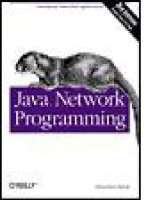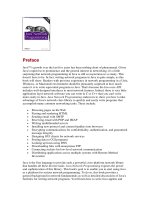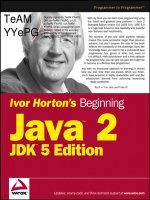OReilly java network programming 3rd edition oct 2004 ISBN 0596007213
Bạn đang xem bản rút gọn của tài liệu. Xem và tải ngay bản đầy đủ của tài liệu tại đây (6.08 MB, 1,660 trang )
•
•
•
•
•
•
TableofContents
Index
Reviews
ReaderReviews
Errata
Academic
JavaNetworkProgramming,3rdEdition
ByElliotteRustyHarold
Publisher :O'Reilly
PubDate :October2004
ISBN :0-596-00721-3
Pages :706
Thoroughlyrevisedtocoverallthe100+
significantupdatestoJavaDevelopersKit
(JDK)1.5,JavaNetworkProgrammingisa
completeintroductiontodevelopingnetwork
programs(bothappletsandapplications)
usingJava,coveringeverythingfrom
networkingfundamentalstoremotemethod
invocation(RMI).ItincludeschaptersonTCP
andUDPsockets,multicastingprotocoland
contenthandlers,servlets,andthenewI/O
API.Thisistheessentialresourceforany
seriousJavadeveloper.
•
•
•
•
•
•
TableofContents
Index
Reviews
ReaderReviews
Errata
Academic
JavaNetworkProgramming,3rdEdition
ByElliotteRustyHarold
Publisher :O'Reilly
PubDate :October2004
ISBN :0-596-00721-3
Pages :706
Copyright
Preface
AbouttheThirdEdition
OrganizationoftheBook
WhoYouAre
AbouttheExamples
RequestforComments
JavaVersions
ConventionsUsedinThisBook
CommentsandQuestions
Acknowledgments
Chapter1.WhyNetworkedJava?
Section1.1.WhatCanaNetworkProgramDo?
Section1.2.Security
Section1.3.ButWait!There'sMore!
Chapter2.BasicNetworkConcepts
Section2.1.Networks
Section2.2.TheLayersofaNetwork
Section2.3.IP,TCP,andUDP
Section2.5.TheClient/ServerModel
Section2.4.TheInternet
Section2.6.InternetStandards
Chapter3.BasicWebConcepts
Section3.1.URIs
Section3.2.HTML,SGML,andXML
Section3.3.HTTP
Section3.4.MIMEMediaTypes
Section3.5.Server-SidePrograms
Chapter4.Streams
Section4.1.OutputStreams
Section4.2.InputStreams
Section4.3.FilterStreams
Section4.4.ReadersandWriters
Chapter5.Threads
Section5.1.RunningThreads
Section5.2.ReturningInformationfromaThread
Section5.4.Deadlock
Section5.3.Synchronization
Section5.5.ThreadScheduling
Section5.6.ThreadPools
Chapter6.LookingUpInternetAddresses
Section6.1.TheInetAddressClass
Section6.2.Inet4AddressandInet6Address
Section6.3.TheNetworkInterfaceClass
Section6.4.SomeUsefulPrograms
Chapter7.URLsandURIs
Section7.1.TheURLClass
Section7.2.TheURLEncoderandURLDecoderClasses
Section7.4.Proxies
Section7.3.TheURIClass
Section7.5.CommunicatingwithServer-SideProgramsThroughGET
Section7.6.AccessingPassword-ProtectedSites
Chapter8.HTMLinSwing
Section8.1.HTMLonComponents
Section8.2.JEditorPane
Section8.3.ParsingHTML
Section8.4.Cookies
Chapter9.SocketsforClients
Section9.1.SocketBasics
Section9.2.InvestigatingProtocolswithTelnet
Section9.3.TheSocketClass
Section9.5.SocketAddresses
Section9.4.SocketExceptions
Section9.6.Examples
Chapter10.SocketsforServers
Section10.1.TheServerSocketClass
Section10.2.SomeUsefulServers
Chapter11.SecureSockets
Section11.1.SecureCommunications
Section11.2.CreatingSecureClientSockets
Section11.3.MethodsoftheSSLSocketClass
Section11.4.CreatingSecureServerSockets
Section11.5.MethodsoftheSSLServerSocketClass
Chapter12.Non-BlockingI/O
Section12.1.AnExampleClient
Section12.2.AnExampleServer
Section12.4.Channels
Section12.3.Buffers
Section12.5.ReadinessSelection
Chapter13.UDPDatagramsandSockets
Section13.1.TheUDPProtocol
Section13.2.TheDatagramPacketClass
Section13.3.TheDatagramSocketClass
Section13.4.SomeUsefulApplications
Section13.5.DatagramChannel
Chapter14.MulticastSockets
Section14.1.WhatIsaMulticastSocket?
Section14.2.WorkingwithMulticastSockets
Section14.3.TwoSimpleExamples
Chapter15.URLConnections
Section15.1.OpeningURLConnections
Section15.2.ReadingDatafromaServer
Section15.3.ReadingtheHeader
Section15.5.ConfiguringtheClientRequestHTTPHeader
Section15.4.ConfiguringtheConnection
Section15.6.WritingDatatoaServer
Section15.8.TheObjectMethods
Section15.10.GuessingMIMEContentTypes
Section15.12.Caches
Section15.7.ContentHandlers
Section15.9.SecurityConsiderationsforURLConnections
Section15.11.HttpURLConnection
Section15.13.JarURLConnection
Chapter16.ProtocolHandlers
Section16.1.WhatIsaProtocolHandler?
Section16.2.TheURLStreamHandlerClass
Section16.3.WritingaProtocolHandler
Section16.4.MoreProtocolHandlerExamplesandTechniques
Section16.5.TheURLStreamHandlerFactoryInterface
Chapter17.ContentHandlers
Section17.1.WhatIsaContentHandler?
Section17.2.TheContentHandlerClass
Section17.3.TheContentHandlerFactoryInterface
Section17.4.AContentHandlerfortheFITSImageFormat
Chapter18.RemoteMethodInvocation
Section18.1.WhatIsRemoteMethodInvocation?
Section18.2.Implementation
Section18.4.Thejava.rmiPackage
Section18.3.LoadingClassesatRuntime
Section18.5.Thejava.rmi.registryPackage
Section18.6.Thejava.rmi.serverPackage
Chapter19.TheJavaMailAPI
Section19.1.WhatIstheJavaMailAPI?
Section19.2.SendingEmail
Section19.4.PasswordAuthentication
Section19.6.TheURLNameClass
Section19.8.ThePartInterface
Section19.10.MIMEMessages
Section19.3.ReceivingMail
Section19.5.Addresses
Section19.7.TheMessageClass
Section19.9.MultipartMessagesandFileAttachments
Section19.11.Folders
Colophon
Index
Copyright©2005,2000,1997O'ReillyMedia,Inc.Allrights
reserved.
PrintedintheUnitedStatesofAmerica.
PublishedbyO'ReillyMedia,Inc.,1005GravensteinHighway
North,Sebastopol,CA95472.
O'Reillybooksmaybepurchasedforeducational,business,or
salespromotionaluse.Onlineeditionsarealsoavailablefor
mosttitles().Formoreinformation,
contactourcorporate/institutionalsalesdepartment:(800)
998-9938or
NutshellHandbook,theNutshellHandbooklogo,andthe
O'ReillylogoareregisteredtrademarksofO'ReillyMedia,Inc.
Java™NetworkProgramming,ThirdEdition,theimageofa
riverotter,andrelatedtradedressaretrademarksofO'Reilly
Media,Inc.
Java™andallJava-basedtrademarksandlogosaretrademarks
orregisteredtrademarksofSunMicrosystems,Inc.,inthe
UnitedStatesandothercountries.O'ReillyMedia,Inc.is
independentofSunMicrosystems.
Manyofthedesignationsusedbymanufacturersandsellersto
distinguishtheirproductsareclaimedastrademarks.Where
thosedesignationsappearinthisbook,andO'ReillyMedia,Inc.
wasawareofatrademarkclaim,thedesignationshavebeen
printedincapsorinitialcaps.
Whileeveryprecautionhasbeentakeninthepreparationofthis
book,thepublisherandauthorassumenoresponsibilityfor
errorsoromissions,orfordamagesresultingfromtheuseof
theinformationcontainedherein.
Preface
Java'sgrowthoverthelast10yearshasbeennothingshortof
phenomenal.GivenJava'srapidrisetoprominenceandthe
evenmorespectaculargrowthoftheInternet,it'salittle
surprisingthatnetworkprogramminginJavaisstillso
mysterioustosomany.Itdoesn'thavetobe.Infact,writing
networkprogramsinJavaisquitesimple,asthisbookwill
show.Readerswithpreviousexperienceinnetwork
programminginaUnix,Windows,orMacintoshenvironment
shouldbepleasantlysurprisedathowmucheasieritistowrite
equivalentprogramsinJava.TheJavacoreAPIincludeswelldesignedinterfacestomostnetworkfeatures.Indeed,thereis
verylittleapplication-layernetworksoftwareyoucanwriteinC
orC++thatyoucan'twritemoreeasilyinJava.JavaNetwork
Programming,3rdEditionendeavorstoshowyouhowtotake
advantageofJava'snetworkclasslibrarytoquicklyandeasily
writeprogramsthataccomplishmanycommonnetworking
tasks.Someoftheseinclude:
BrowsingtheWebwithHTTP
ParsingandrenderingHTML
SendingemailwithSMTP
ReceivingemailwithPOPandIMAP
Writingmultithreadedservers
Installingnewprotocolandcontenthandlersintobrowsers
Encryptingcommunicationsforconfidentiality,
authentication,andguaranteedmessageintegrity
DesigningGUIclientsfornetworkservices
Postingdatatoserver-sideprograms
LookinguphostsusingDNS
DownloadingfileswithanonymousFTP
Connectingsocketsforlow-levelnetworkcommunication
Distributingapplicationsacrossmultiplesystemswith
RemoteMethodInvocation
Javaisthefirstlanguagetoprovidesuchapowerfulcrossplatformnetworklibrary,whichhandlesallthesediversetasks.
JavaNetworkProgrammingexposesthepowerand
sophisticationofthislibrary.Thisbook'sgoalistoenableyouto
startusingJavaasaplatformforseriousnetwork
programming.Todoso,thisbookprovidesageneral
backgroundinnetworkfundamentals,aswellasdetailed
discussionsofJava'sfacilitiesforwritingnetworkprograms.
You'lllearnhowtowriteJavaprogramsthatsharedataacross
theInternetforgames,collaboration,softwareupdates,file
transfer,andmore.You'llalsogetabehind-the-sceneslookat
HTTP,SMTP,TCP/IP,andtheotherprotocolsthatsupportthe
InternetandtheWeb.Whenyoufinishthisbook,you'llhave
theknowledgeandthetoolstocreatethenextgenerationof
softwarethattakesfulladvantageoftheInternet.
AbouttheThirdEdition
In1996,inthefirstchapterofthefirsteditionofthisbook,I
wroteextensivelyaboutthesortofdynamic,distributed
networkapplicationsIthoughtJavawouldmakepossible.One
ofthemostexcitingpartsofwritingsubsequenteditionshas
beenseeingvirtuallyalloftheapplicationsIforetoldcometo
pass.ProgrammersareusingJavatoquerydatabaseservers,
monitorwebpages,controltelescopes,managemultiplayer
games,andmore,allbyusingJava'snativeabilitytoaccessthe
Internet.JavaingeneralandnetworkprogramminginJavain
particularhasmovedwellbeyondthehypestageandintothe
realmofreal,workingapplications.Notallnetworksoftwareis
yetwritteninJava,butit'snotforalackoftrying.Effortsare
wellunderwaytosubverttheexistinginfrastructureofC-based
networkclientsandserverswithpureJavareplacements.
ClientsfornewerprotocolslikeGnutellaandFreenetare
preferentiallywritteninJava.It'sunlikelythatJavawillreplace
Cforallnetworkprogramminginthenearfuture.However,the
merefactthatmanypeoplearewillingtousewebbrowsers,
webservers,andmorewritteninJavashowsjusthowfarwe've
comesince1996.
Thisbookhascomealongway,too.Thethirdeditionhasone
completelynewchaptertodescribethemostsignificant
developmentinnetworkprogrammingsincereadersandwriters
wereintroducedinJava1.1.IreferofcoursetothenewI/O
APIsinthejava.niopackage.Theabilitytoperform
asynchronous,non-blockingI/Ooperationsiscriticalforhighperformancenetworkapplications,especiallyservers.It
removesoneofthelastbarrierstousingJavafornetwork
servers.Manyotherchaptershavebeenupdatedtotake
advantageofthesenewI/OAPIs.
There'vebeenlotsofothersmallchangesandupdates
throughoutthejava.netandsupportingpackagesinJava1.4
and1.5,andthesearecoveredhereaswell.Newclasses
addressedinthiseditionincludeCookieHandler,
SocketAddress,Proxy,NetworkInterface,andURI.IPv6has
becomeareality,andisnowcoveredextensively.Manyother
methodshavebeenaddedtoexistingclassesinthelasttwo
releasesofJava,andthesearediscussedintherelevant
chapters.I'vealsorewrittenlargepartsofthebooktoreflect
changingfashionsinJavaprogrammingingeneralandnetwork
programminginparticular.AppletsandCGIprogramsare
emphasizedmuchless.Intheirplace,you'llfindmoregeneric
discussionofremotecodeexecutionandserver-side
environments,howeverimplemented.
Ofcourse,thetexthasbeencleanedup,too.There'sonlyone
completelynewchapterhere,butthe18existingchaptershave
beenextensivelyrewrittenandexpandedtobringthemup-todatewithnewdevelopmentsaswellastomakethemclearer
andmoreengaging.Ihopeyou'llfindthisthirdeditionaneven
stronger,longer-lived,moreaccurate,andmoreenjoyable
tutorialandreferencetonetworkprogramminginJavathanthe
lastedition.
OrganizationoftheBook
Thisbookbeginswiththreechaptersthatoutlinehownetworks
andnetworkprogramswork.Chapter1,isagentleintroduction
tonetworkprogramminginJavaandtheapplicationsitmakes
possible.Allreadersshouldfindsomethingofinterestinthis
chapter.Itexploressomeoftheuniqueprogramsthatbecome
feasiblewhennetworkingiscombinedwithJava.Chapter2,and
Chapter3,explainindetailwhataprogrammerneedstoknow
abouthowtheInternetandtheWebwork.Chapter2describes
theprotocolsthatunderlietheInternet,suchasTCP/IPand
UDP/IP.Chapter3describesthestandardsthatunderliethe
Web,suchasHTTP,HTML,andREST.Ifyou'vedonealotof
networkprogramminginotherlanguagesonotherplatforms,
youmaybeabletoskipthesetwochapters.
ThenexttwochaptersthrowsomelightontwopartsofJava
programmingthatarecriticaltoalmostallnetworkprograms
butareoftenmisunderstoodandmisused,I/Oandthreading.
Chapter4,exploresJava'sclassicI/Omodelswhich,despitethe
newI/OAPIs,aren'tgoingawayanytimesoonandarestillthe
preferredmeansofhandlinginputandoutputinmostclient
applications.UnderstandinghowJavahandlesI/Ointhegeneral
caseisaprerequisiteforunderstandingthespecialcaseofhow
JavahandlesnetworkI/O.Chapter5,exploresmultithreading
andsynchronization,withaspecialemphasisonhowtheycan
beusedforasynchronousI/Oandnetworkservers.Experienced
Javaprogrammersmaybeabletoskimorskipthesetwo
chapters.However,Chapter6,isessentialreadingforeveryone.
ItshowshowJavaprogramsinteractwiththedomainname
systemthroughtheInetAddressclass,theoneclassthat's
neededbyessentiallyallnetworkprograms.Onceyou've
finishedthischapter,it'spossibletojumparoundinthebookas
yourinterestsandneedsdictate.Thereare,however,some
interdependenciesbetweenspecificchapters.FigureP-1should
allowyoutomapoutpossiblepathsthroughthebook.
FigureP-1.Chapterprerequisites
Chapter7,URLsandURIs,exploresJava'sURLclass,apowerful
abstractionfordownloadinginformationandfilesfromnetwork
serversofmanykinds.TheURLclassenablesyoutoconnectto
anddownloadfilesanddocumentsfromanetworkserver
withoutconcerningyourselfwiththedetailsoftheprotocolthe
serverspeaks.ItletsyouconnecttoanFTPserverusingthe
samecodeyouusetotalktoanHTTPserverortoreadafileon
thelocalharddisk.
Onceyou'vegotanHTMLfilefromaserver,you'regoingto
wanttodosomethingwithit.ParsingandrenderingHTMLis
oneofthemostdifficultchallengesnetworkprogrammerscan
face.Chapter8,introducessomelittleknownclassesfor
parsingandrenderingHTMLdocumentsthattakethisburden
offyourshouldersandputitonSun's.
Chapter9throughChapter11discussJava'slow-levelsocket
classesfornetworkaccess.Chapter9,introducestheJava
socketsAPIandtheSocketclassinparticular.Itshowsyou
howtowritenetworkclientsthatinteractwithTCPserversofall
kindsincludingwhois,finger,andHTTP.Chapter10,showsyou
howtousetheServerSocketclasstowriteserversforthese
andotherprotocolsinJava.Chapter11,showsyouhowto
protectyourclientservercommunicationsusingtheSecure
SocketsLayer(SSL)andtheJavaSecureSocketsExtension
(JSSE).
Chapter12,coversthenewI/OAPIsintroducedinJava1.4.
TheseAPIswerespecificallydesignedfornetworkservers.They
enableaprogramtofigureoutwhetheraconnectionisready
beforeittriestoreadfromorwritetothesocket.Thisallowsa
singlethreadtomanagemanydifferentconnections
simultaneously,therebyplacingmuchlessloadonthevirtual
machine.ThenewI/OAPIsdon'thelpmuchforsmallserversor
clientsthatdon'topenmanysimultaneousconnections,but
theyprovidehugeperformanceboostsforhighvolumeservers
thatwanttotransmitasmuchdataasthenetworkcanhandle
asfastasthenetworkcandeliverit.
Chapter13,introducestheUserDatagramProtocol(UDP)and
theassociatedDatagramPacketandDatagramSocketclasses
thatprovidefast,unreliablecommunication.Finally,Chapter14,
showsyouhowtouseUDPtocommunicatewithmultiplehosts
atthesametime.Alltheotherclassesthataccessthenetwork
fromJavarelyontheclassesdescribedinthesefivechapters.
Chapter15throughChapter17lookmoredeeplyatthe
infrastructuresupportingtheURLclass.Thesechapters
introduceprotocolandcontenthandlers,conceptsuniqueto
Javathatmakeitpossibletowritedynamicallyextensible
softwarethatautomaticallyunderstandsnewprotocolsand
mediatypes.Chapter15,describestheclassthatservesasthe
enginefortheURLclassofChapter7.Itshowsyouhowtotake
advantageofthisclassthroughitspublicAPI.Chapter16,also
focusesontheURLConnectionclassbutfromadifferent
direction;itshowsyouhowtosubclassthisclasstocreate
handlersfornewprotocolsandURLs.Finally,Chapter17,
exploresJava'ssomewhatmoribundmechanismforsupporting
newmediatypes.
Chapter18andChapter19introducetwouniquehigher-level
APIsfornetworkprograms,RemoteMethodInvocation(RMI)
andtheJavaMailAPI.Chapter18,introducesthispowerful
mechanismforwritingdistributedJavaapplicationsthatrun
acrossmultipleheterogeneoussystemsatthesametimewhile
communicatingwithstraightforwardmethodcallsjustlikea
nondistributedprogram.Chapter19,acquaintsyouwiththis
standardextensiontoJava,whichoffersanalternativetolowlevelsocketsfortalkingtoSMTP,POP,IMAP,andotheremail
servers.BothoftheseAPIsprovidedistributedapplicationswith
lesscumbersomealternativestolower-levelprotocols.
WhoYouAre
ThisbookassumesyouarecomfortablewiththeJavalanguage
andprogrammingenvironment,inadditiontoobject-oriented
programmingingeneral.Thisbookdoesnotattempttobea
basiclanguagetutorial.Youshouldbethoroughlyfamiliarwith
thesyntaxofJava.Youshouldhavewrittensimpleapplications
andapplets.YoushouldalsobecomfortablewithbasicAWTand
Swingprogramming.Whenyouencounteratopicthatrequires
adeeperunderstandingfornetworkprogrammingthanis
customaryforinstance,threadsandstreamsI'llcoverthattopic
aswell,atleastbriefly.
YoushouldalsobeanaccomplisheduseroftheInternet.Iwill
assumeyouknowhowtoFTPfilesandvisitwebsites.You
shouldknowwhataURLisandhowyoulocateone.Youshould
knowhowtowritesimpleHTMLandbeabletopublishahome
pagethatincludesJavaapplets,althoughyoudonotneedtobe
asuperwebdesigner.
However,thisbookdoesn'tassumethatyouhaveprior
experiencewithnetworkprogramming.Youshouldfindita
completeintroductiontonetworkingconceptsandnetwork
applicationdevelopment.Idon'tassumethatyouhaveafew
thousandnetworkingacronyms(TCP,UDP,SMTP,etc.)atthetip
ofyourtongue.You'lllearnwhatyouneedtoknowaboutthese
here.It'scertainlypossiblethatyoucouldusethisbookasa
generalintroductiontonetworkprogrammingwithasocket-like
interface,andthengoontolearnWSA(theWindowsSocket
Architecture)andfigureouthowtowritenetworkapplications
inC++.Butit'snotclearwhyyouwouldwantto:asIsaid
earlier,Javaletsyouwriteverysophisticatedapplicationswith
ease.
JavaVersions
Java'snetworkclasseshavechangedalotmoreslowlysince
Java1.0thanotherpartsofthecoreAPI.Incomparisontothe
AWTorI/O,therehavebeenalmostnochangesandonlyafew
additions.Ofcourse,allnetworkprogramsmakeextensiveuse
oftheI/OclassesandmanymakeheavyuseofGUIs.Thisbook
iswrittenwiththeassumptionthatyouandyourcustomersare
usingatleastJava1.1.Ingeneral,IuseJava1.1featureslike
readersandwritersandtheneweventmodelfreelywithout
furtherexplanation.
Java2isabitmoreofastretch.AlthoughIwrotealmostthis
entirebookusingJava2,andalthoughJava2hasbeen
availableformostplatformsforseveralyears,noJava2
runtimeordevelopmentenvironmentisyetavailableforMacOS
9.ItisvirtuallycertainthatneitherApplenorSunwilleverport
anyversionofJava2toMacOS9.xorearlier,thuseffectively
lockingout60%ofthecurrentMac-installedbasefromfuture
developments.Thisisnotagoodthingforalanguagethat
claimstobe"writeonce,runanywhere."Furthermore,
Microsoft'sJavavirtualmachinesupportsJava1.1onlyand
doesnotseemlikelytoimproveinthisrespectforthe
foreseeablefuture.Thus,whileIhavenotshiedawayfrom
usingJava2-specificfeatureswheretheyseemedusefulor
convenientforinstance,theASCIIencodingforthe
InputStreamReaderandthekeytoolprogramIhavebeen
carefultopointoutmyuseofsuchfeatures.Where1.1safe
alternativesexist,theyarenoted.Whenaparticularmethodor
classisnewinJava1.2orlater,itisnotedbyacomment
followingitsdeclarationlikethis:
publicvoidsetTimeToLive(intttl)throwsIOException//Java1
Tofurthermuddythewaters,therearemultipleversionsof
Java2.Atthetimethisbookwascompleted,thecurrent
releasewasthe"Java™2SDK,StandardEdition,v1.4.2_05".
Atleastthat'swhatitwascalledthen.Sunseemstochange
namesatthedropofamarketingconsultant.Inprevious
incarnations,thisiswhatwassimplyknownastheJDK.Sun
alsomakesavailablethe"Java™2Platform,EnterpriseEdition
(J2EE©)"and"Java™2Platform,MicroEdition(J2ME©)".The
EnterpriseEditionisasupersetofthestandardeditionthat
addsfeaturesliketheJavaNamingandDirectoryInterfaceand
theJavaMailAPIthatprovidehigh-levelAPIsfordistributed
applications.MostoftheseadditionalAPIsarealsoavailableas
extensionstothestandardedition,andwillbesotreatedhere.
TheMicroEditionisasubsetofthestandardeditiontargetedat
cellphones,set-topboxes,andothermemory,CPU,and
display-challengeddevices.ItremovesalotoftheGUIAPIs
programmershavelearnedtoassociatewithJava,although
surprisinglyitretainsmanyofthebasicnetworkingandI/O
classesdiscussedinthisbook.Finally,whenthisbookwas
abouthalfcomplete,Sunreleasedabetaofthe"Java™2SDK,
StandardEdition,v1.5".Thisaddedafewpiecestothe
networkingAPI,butleftmostoftheexistingAPIuntouched.
OverthenextfewmonthsSunreleasedseveralmorebetasof
JDK1.5.Thefinishingtoucheswereplacedonthisbookandall
thecodetestedwithJDK1.5beta2.Youshouldn'thaveany
troubleusingthisbookafter1.5isreleased.Withanyluckat
all,discrepanciesbetweenthefinalspecificationandwhatI
discussherewillbequiteminor.
Tobehonest,themostannoyingproblemwithallthese
differentversionsandeditionswasnottherewritingthey
necessitated.Itwasfiguringouthowtoidentifytheminthe
text.IsimplyrefusetowriteJava™2SDK,StandardEdition,
v1.3orevenJava21.3everytimeIwanttopointoutanew
featureinthelatestreleaseofJava.Inormallysimplyreferto
Java1.1,Java1.2,Java1.3,Java1.4,andJava1.5.Overall,
though,thenetworkingAPIseemsfairlystable.Java1.1
throughJava1.3areverysimilar,andthereareafewonly
majoradditionsinJava1.4and1.5.Verylittleofthepost-1.0
networkingAPIhasbeendeprecated.
AbouttheExamples
Mostmethodsandclassesdescribedinthisbookareillustrated
withatleastonecompleteworkingprogram,simplethoughit
maybe.Inmyexperience,acompleteworkingprogramis
essentialtoshowingtheproperuseofamethod.Withouta
program,itistooeasytodropintojargonortoglossover
pointsaboutwhichtheauthormaybeunclearinhisownmind.
TheJavaAPIdocumentationitselfoftensuffersfromexcessively
tersedescriptionsofthemethodcalls.Inthisbook,Ihavetried
toerronthesideofprovidingtoomuchexplicationratherthan
toolittle.Ifapointisobvioustoyou,feelfreetoskipoverit.
Youdonotneedtotypeinandruneveryexampleinthisbook,
butifaparticularmethoddoesgiveyoutrouble,youare
guaranteedtohaveatleastoneworkingexample.
Eachchapterincludesatleastone(andoftenseveral)more
complexprogramsthatdemonstratetheclassesandmethodsof
thatchapterinamorerealisticsetting.TheseoftenrelyonJava
featuresnotdiscussedinthisbook.Indeed,inmanyofthe
programs,thenetworkingcomponentsareonlyasmallfraction
ofthesourcecodeandoftentheleastdifficultparts.
Nonetheless,noneoftheseprogramscouldbewrittenaseasily
inlanguagesthatdidn'tgivenetworkingthecentralpositionit
occupiesinJava.Theapparentsimplicityofthenetworked
sectionsofthecodereflectstheextenttowhichnetworkinghas
beenmadeacorefeatureofJava,andnotanytrivialityofthe
programitself.Allexampleprogramspresentedinthisbookare
availableonline,oftenwithcorrectionsandadditions.Youcan
downloadthesourcecodefrom
/>ThisbookassumesyouareusingSun'sJavaDevelopmentKit.I
havetestedalltheexamplesonLinuxandmanyonWindows
andMacOSX.Almostalltheexamplesgivenhereshouldwork
onotherplatformsandwithothercompilersandvirtual
machinesthatsupportJava1.2(andmostonJava1.1,aswell).
TheoccasionalexamplesthatrequireJava1.3,1.4,or1.5are
clearlynoted.
ConventionsUsedinThisBook
BodytextisTimesRoman,normal,likeyou'rereadingnow.
Amonospacedtypewriterfontisusedfor:
Codeexamplesandfragments
AnythingthatmightappearinaJavaprogram,including
keywords,operators,datatypes,methodnames,variable
names,classnames,andinterfacenames
Programoutput
TagsthatmightappearinanHTMLdocument
Aboldmonospacedfontisusedfor:
Commandlinesandoptionsthatshouldbetypedverbatim
onthescreen
Anitalicizedfontisusedfor:
Newtermswheretheyaredefined
Pathnames,filenames,andprogramnames(however,ifthe
programnameisalsothenameofaJavaclass,itisgiven
inamonospacedfont,likeotherclassnames)
Hostanddomainnames(java.oreilly.com)
URLs( />
Titlesofotherchaptersandbooks(JavaI/O)
Significantcodefragmentsandcompleteprogramsare
generallyplacedintoaseparateparagraph,likethis:
Sockets=newSocket("java.oreilly.com",80);
if(!s.getTcpNoDelay())s.setTcpNoDelay(true);
Whencodeispresentedasfragmentsratherthancomplete
programs,theexistenceoftheappropriateimportstatements
shouldbeinferred.Forexample,intheabovecodefragment
youmayassumethatjava.net.Socketwasimported.
Someexamplesintermixuserinputwithprogramoutput.In
thesecases,theuserinputwillbedisplayedinbold,asinthis
examplefromChapter9:
%telnetrama.poly.edu7
Trying128.238.10.212...
Connectedtorama.poly.edu.
Escapecharacteris'^]'.
Thisisatest
Thisisatest
Thisisanothertest
Thisisanothertest
9876543210
9876543210
^]
telnet>close
Connectionclosed.
TheJavaprogramminglanguageiscase-sensitive.
Java.net.socketisnotthesameasjava.net.Socket.Casesensitiveprogramminglanguagesdonotalwaysallowauthors
toadheretostandardEnglishgrammar.Mostofthetime,it's
possibletorewritethesentenceinsuchawaythatthetwodo
notconflict,andwhenpossibleIhaveendeavoredtodoso.
However,onthoserareoccasionswhenthereissimplynoway
aroundtheproblem,IhaveletstandardEnglishcomeupthe
loser.Inkeepingwiththisprinciple,whenIwanttorefertoa
classoraninstanceofaclassinbodytext,Iusethe
capitalizationthatyou'dseeinsourcecode,generallyaninitial
capitalwithinternalcapitalizationforexample,ServerSocket.
Throughoutthisbook,IusetheBritishconventionofplacing
punctuationinsidequotationmarksonlywhenpunctuationis
partofthematerialquoted.AlthoughIlearnedgrammarunder
theAmericanrules,theBritishsystemhasalwaysseemedfar
morelogicaltome,evenmoresothanusualwhenonemust
quotesourcecodewhereamissingoraddedcomma,period,or
semicoloncanmakethedifferencebetweencodethatcompiles
andcodethatdoesn't.
Finally,althoughmanyoftheexamplesusedherearetoy
examplesunlikelytobereused,afewoftheclassesIdevelop
haverealvalue.Pleasefeelfreetoreusethemoranypartsof
theminyourowncode.Nospecialpermissionisrequired.As
farasIamconcerned,theyareinthepublicdomain(although
thesameismostdefinitelynottrueoftheexplanatorytext!).
Suchclassesareplacedsomewhereinthecom.macfaqpackage,
generallymirroringthejavapackagehierarchy.Forinstance,
Chapter4'sSafePrintWriterclassisinthecom.macfaq.io
package.Whenworkingwiththeseclasses,don'tforgetthatthe
compiled.classfilesmustresideindirectoriesmatchingtheir
packagestructureinsideyourclasspath,andthatyou'llhaveto
importtheminyourownclassesbeforeyoucanusethem.The
book'swebpageat />includesajarfilecontainingalltheseclassesthatcanbe
installedinyourclasspath.
Indicatesatip,suggestion,orgeneralnote.
Indicatesawarningorcaution.









